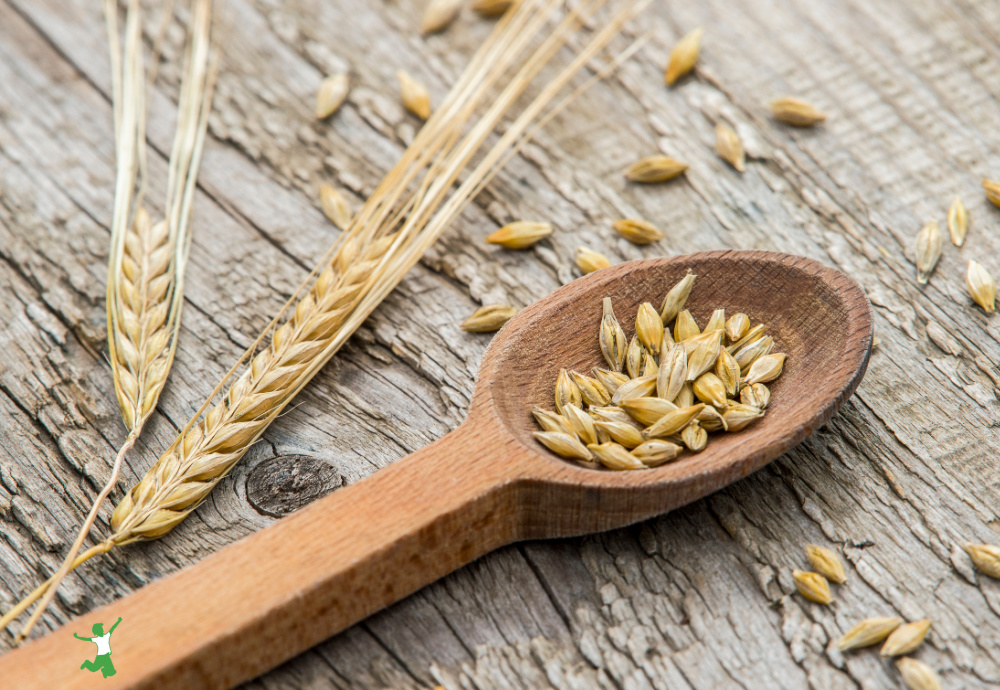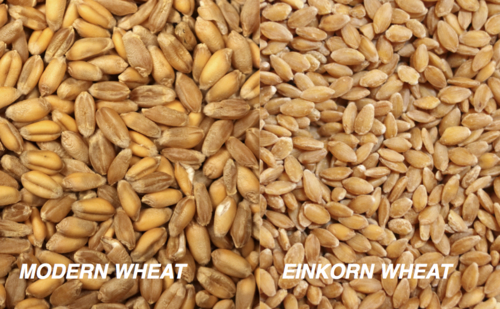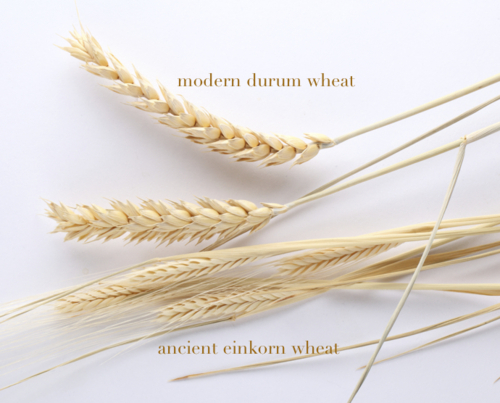There are four big reasons why einkorn is, by far, the best form of wheat to eat even when compared to other ancient grains like spelt, emmer, and kamut.

Most people who love to bake bread, pastries, and other goodies do not realize that einkorn is the best type of wheat to use.
Twenty-five or so years ago, I used to purchase organic white wheat (hard and soft) and spelt in bulk from a local grain co-op for my baking endeavors.
Grinding grain into fresh flour is certainly the most nutritious and tastiest way to bake! I also did this to avoid the conventional toxic wheat desiccated with gut-destroying glyphosate.
Caveat: Baking with freshly ground flour is only better if the bread is traditionally prepared.
Otherwise, the antinutrients like phytic acid are not broken down and harm to gut health is likely over time.
There certainly is a huge difference between modern processed wheat (hybridized by irradiation) and the organic, ancient grains you grind yourself at home.
I remember when I was breastfeeding my youngest child, if I ate so much as a mouthful or two of processed wheat at a restaurant, she would spit up for one or sometimes even two days!
If I ate organic wheat that I ground myself and either sprouted, soaked, or sour-leavened (sourdough), however, she never had any spit-up issues.
To me, this was a huge testament to the radically improved digestibility of wheat that is prepared using the wise methods of ancestral cultures.
Beware of persuasive influencers who claim that all you need to do is grind freshly ground flour and bake bread with baker’s yeast with no proper preparation such as soaking, sprouting or sour-leaving the dough necessary.
This approach is not how traditional societies ever baked their bread, and it is a recipe for serious gut issues!
Most people do not know that baker’s yeast is actually a modern invention only used in the past few centuries!
It quickly gained traction because it made baking faster and easier (NOT healthier). This is the case even when using freshly ground flour!
These quick rise breads using baker’s yeast gradually displaced traditional sourdough to the detriment of those who embraced this early “modern” cooking convenience.
Einkorn Benefits over Modern Wheat
With traditional baking the way to go (using a sourdough starter and NOT baker’s yeast), let’s talk about einkorn as the best type of wheat to bake with.
There are four reasons why I prefer to bake with einkorn wheat and no other type of ancient grains.
This isn’t to say I never use anything else, but if given the choice, I prefer to use einkorn.
Note that einkorn is not to be confused with farro or heirloom wheat.
Better Taste
My first experience baking with einkorn occurred after I received a thoughtful gift of, among other things, einkorn flour and wheat berries. I was delighted when I ground the einkorn into flour and saw how light and white it was.
I am not a fan of bran and am not of the food philosophy that all that fiber is actually good for your gut.
Fiber is a band-aid that covers up the root causes of constipation, a very common symptom of gut imbalance.
I recommend the book Fiber Menance as a good read on the subject.
The truth is that the unhybridized form of wheat…einkorn is the only one…does not have that much bran!
I was thrilled to see that my family thoroughly enjoyed the soaked waffles made with freshly ground einkorn flour.
Later on, I learned to make sprouted einkorn waffles that were more convenient but still highly digestible.
From that point, I gradually incorporated using einkorn for all my baking needs including this very popular no knead sourdough bread recipe.
Most Digestible
Because einkorn is unhybridized and low in bran, it is the most digestible form of wheat you can eat.
While my properly prepared grain dishes made with white wheat or spelt digest fine for our family, you can tell that the same dishes make with einkorn feel even better in the stomach.
This is possibly because einkorn contains good gluten, different on a molecular level from modern gluten in all other forms of wheat including ancient grains like spelt.
Better digestion means better absorption of nutrients, so einkorn surpasses the competition in that category as well.
Visually Distinctive

The first thing I noticed when I ground einkorn into flour for the first time was how much smaller a grain of einkorn is compared with a grain of modern wheat. They are about half the size!
In addition, I noticed that my grain grinder makes less noise when grinding einkorn berries into fresh flour because of softer, low bran kernels.
The distinctive crease on one side of a grain of modern wheat is also absent from kernels of einkorn.
The reason for the differences is that over the centuries, the genetics of wheat gradually changed due to human cultivation practices.
Year after year, farmers selected the seeds at harvest time that suited the goal of higher yields and MORE gluten.
This worked best for big farms and larger-scale agriculture, production, and distribution of wheat products.
The ONLY Unhybridized Wheat

Einkorn is like most plants in that it is diploid.
This means that einkorn contains only 2 sets of chromosomes.
About 2,000 years after einkorn wheat, nature created emmer via the natural hybridization of 2 wild grasses.
Consequently, emmer has 4 sets of chromosomes. Kamut and durum (bulgur) wheat are both descendants of emmer.
Spelt, an heirloom wheat, is the result of hybridization between cultivated emmer and another wild grass. Thus, spelt contains six sets of chromosomes.
Modern wheat is a descendant of spelt.
As you can see, einkorn is the purest and most ancient form of wheat available. With only 2 sets of chromosomes, a very different composition of gluten, and low bran, it is the most digestible form of wheat for baking at home.
Where to Source Quality Einkorn
The only downside of einkorn is that it is not widely available and tends to be more expensive than other types of wheat. It is still quite new to the North American market.
If you are sourcing organic einkorn berries, I recommend this quality brand.
If you need organic sprouted einkorn berries for more convenient baking, this farm based in the United States is my preferred source.
Have you tried einkorn wheat yet? If so, what observations have you made about this ancient, unhybridized wheat?









I bought the Einkhorn all purpose flour from Amazon. I have to use it with recipes that specify that flour since it doesn’t seem to come out the same using any of my other recipes. It takes less liquid so beware when using it.
Hi Sarah:
Thank you for your posting, I’d love to try out the einkorn berry, but I read from some Amazon review, said the berry is unsproutable, is that true? I’d love to sprout it before grind to flour.
Thanks,
Jenny
Einkorn can definitely be sprouted. I purchase sprouted einkorn flour from Jovial Foods.
Thank you for this article, Sarah!
It was pleasure and interesting to read it and learn more about einkorn being used in America. I live in the UK but I am originally from Bulgaria (Southeast Europe). In the last 5-6 years there’s been increasing number of farms growing this crop (not in massive amounts but seeing it in the supermarkets is so encouraging!) and currently several companies are selling beautiful organic einkorn there , I believe some of them export it too. I have gluten intolerance and I find anything made of 100% einkorn amazing, light and nutritious! The einkorn bread is soo tasty and beautiful, fulfilling, it is actually more than physical nutrition for the body, it is so pure and it nourishes one’s spiritual nature as well!. When I eat einkorn bread it brings me such feeling of gratitude .., it is hard to describe. It is real food like nothing else. I hope more people will be interested in growing this crop in the future and welcome it back to return in all people’s diet again. Thank you for your reccommendations on the book, will check it out!
So Sarah, where can I purchase real einkorn wheat from Tuscany?
There is a link in the article to a reliable source that I use myself 🙂
We have switched to einkorn and love it! But I’m having issues converting some of my favorite recipes because of how “weird” einkorn can be. I know it takes longer to hydrate, but am not sure how to compensate for that and still get light and fluffy results. I love mixing up a huge batch of muffins which I freeze unbaked and then bake as I need (thanks to King Arthur flour for the idea). If I bake some up immediately before freezing, they barely rise. The texture is fine, but they stay small. The exact same batter frozen for at least overnight, bakes up twice as tall and super fluffy. I tried compensating with fresh batter by letting it sit 30 minutes before baking, to fully hydrate, but no – just as flat. I can’t freeze everything before baking! How can I work around this need to hydrate slowly without having my yeast/sourdough/baking powder go flat by the time the item is ready to bake?
I tried using einkorn flour awhile back–and couldn’t find bread recipes that turned out convincingly like regular loaves. Most of my family will eat it, but a few picky people are turned off because of the loaf’s rise (if I remember correctly).
I’d rather make a loaf of 100% einkorn, but ended up mixing the ingredients with modern-day wheat flour. Suggestions? I’d like to make this work so that my whole family is eating fresh bread again.
If you are baking with einkorn, this cookbook is very helpful: http://amzn.to/2b0ifz5
Thanks, Sarah! Do you know if that book has 100% einkorn bread recipes? I don’t want to use white flour or wheat flour.
Yes, the bread recipes are all einkorn. I actually took an einkorn class with the author in Tuscany last year. Highly recommend that einkorn book. She knows einkorn probably better than anyone else in the world at the moment.
Bere is a 6 sided type of barley and is also another ancient grain and found in northern Scotland. I am from Scotland and even i can’t find organic bere anywhere near me at all. I am very much interested in this einkorn though and hope to start buying and using this. Be nice to know if others have tried Bere though which is pronounced as bear.
Have been cooking with einkorn for about a year. Love the pale yellow color or the flour and the color of cakes, breads, etc.. I do not have celiac disease but do not wheat sensitivity. No problems with einkorn.. First learned of einkorn in the book, Wheat Belly.. Have not yet purchased the berries to grind.
Hi Sarah
I am just in process of trying the wholemeal einkorn flour, I made the kefir bread from your recipe it is really tasty but no good for my stomach, I do have gluten sensitivity (no celiac) and dairy intolerance but I do well on raw milk and kefir. I do ferment my flours but mainly eat buckwheat and teff, I usually ferment it for several days, unfermented buckwheat will give me digestive problems as well. I also had made some pancakes of this kefir fermented pastry and they were so good,.. Do you think that white einkorn flour would be easier to digest?
I really don’t know. Everyone is so different with sensitivities and such these days. You will have to try it and see.
hi I was wondering what recipes you use for teff and buckwheat and if you can post some?
There is now a wonderful source of organic einkorn grain in the United States. Bluebird Grain Farms, out of Winthrop, Washington. They’ll even give a good discount for first-time orders and they’ll can sell wholesale if you and a resale number and want to do group orders as a way to share costs.
Thanks!
Alice Osborne
Alpine, UT
Thanks for the tip. I’ve been trying to find the lowest price fresh einkorn.